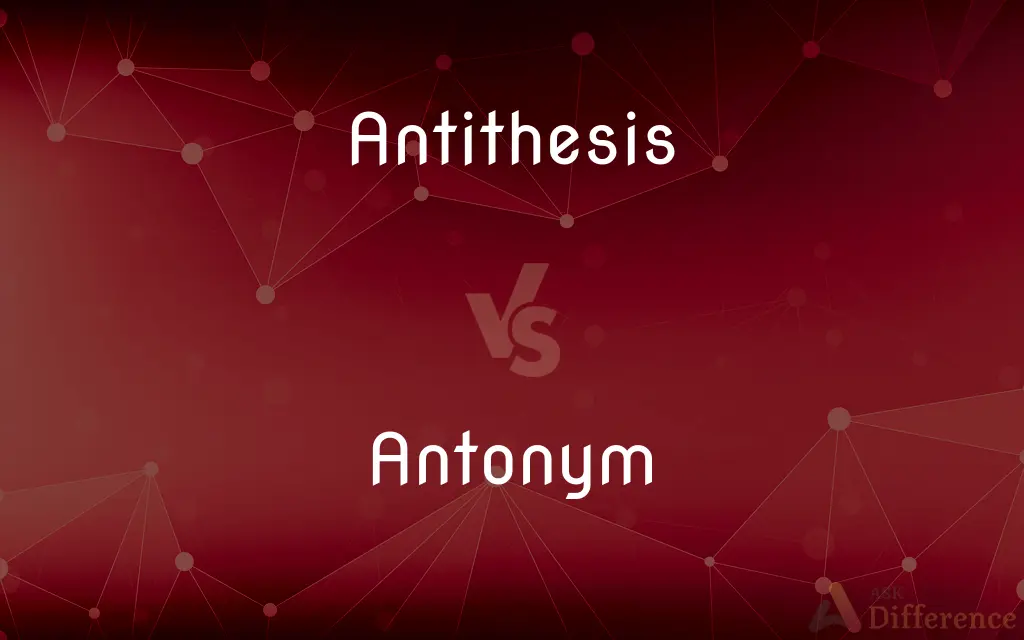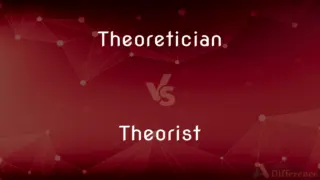Antithesis vs. Antonym — What's the Difference?
By Tayyaba Rehman & Maham Liaqat — Updated on April 23, 2024
Antithesis involves juxtaposing contrasting ideas or phrases to highlight differences, often in parallel structures, whereas an antonym is simply a word with a meaning opposite to that of another word.

Difference Between Antithesis and Antonym
Table of Contents
ADVERTISEMENT
Key Differences
Antithesis is a rhetorical device used in writing and speech to present contrasting ideas in a way that emphasizes their differences, often enhancing the impact of the message. Whereas, antonym refers to the relationship between words that have opposite meanings, useful in language to express contrasting concepts.
In literature, antithesis is employed to create a vivid distinction through the balance of opposite terms, enhancing themes or characters. On the other hand, antonyms are used in everyday language and are part of basic vocabulary, helping to describe the world in terms of binary opposites like hot and cold, or light and dark.
Antithesis can be found in famous speeches and writings, where it serves to make arguments more persuasive and memorable by clearly delineating opposing viewpoints. In contrast, antonyms are fundamental to language structure and are taught from early education, aiding in the development of descriptive and communicative skills.
While antithesis often requires a crafted setup within sentences or paragraphs to showcase the contrast effectively, antonyms are straightforward and function within the language system to denote direct opposites, requiring no special arrangement for their use.
In rhetoric, antithesis enhances the emotional appeal of a discourse by highlighting the stark differences between two opposing ideas, making the choice or distinction clear to the audience. Conversely, antonyms play a critical role in language comprehension and vocabulary expansion, offering clear options for expression without the rhetorical flourish.
ADVERTISEMENT
Comparison Chart
Definition
A rhetorical device that juxtaposes contrasting ideas
A word with an opposite meaning to another word
Usage
Enhances rhetoric and writing by emphasizing differences
Used in language to express simple opposites
Role in Language
Dramatic and persuasive tool in speech and literature
Basic component of vocabulary and language structure
Complexity
Requires thoughtful placement and parallel structures
Simple and direct, used without specific structural needs
Educational Focus
Studied in advanced writing and literature classes
Introduced in early education, fundamental to language learning
Compare with Definitions
Antithesis
A rhetorical device that contrasts two opposing ideas in a parallel structure.
To err is human; to forgive, divine.
Antonym
Helps in enhancing communication clarity.
The room was dark, so I turned on the light.
Antithesis
Often found in speeches to highlight significant differences.
Ask not what your country can do for you ask what you can do for your country.
Antonym
Words that are direct opposites in meaning.
Hot and cold.
Antithesis
Serves to make written or spoken arguments more memorable.
Man proposes, God disposes.
Antonym
Essential in language education for teaching opposites.
Big and small are antonyms.
Antithesis
Used to enhance the effect of a message by juxtaposing contrasting ideas.
It was the best of times, it was the worst of times.
Antonym
Fundamental to vocabulary, enhancing descriptive ability.
The water was shallow, unlike the deep end of the pool.
Antithesis
Can be used to emphasize a moral or ethical distinction.
Freedom is never voluntarily given by the oppressor; it must be demanded by the oppressed.
Antonym
Used routinely in everyday speech to describe contrasting qualities.
She was sad when she failed the test, but happy when she passed the next.
Antithesis
Antithesis (Greek for "setting opposite", from ἀντί "against" and θέσις "placing") is used in writing or speech either as a proposition that contrasts with or reverses some previously mentioned proposition, or when two opposites are introduced together for contrasting effect. This is based on the logical phrase or term.Antithesis can be defined as "a figure of speech involving a seeming contradiction of ideas, words, clauses, or sentences within a balanced grammatical structure.
Antonym
A word having a meaning opposite to that of another word
The word "wet" is an antonym of the word "dry.".
Antithesis
Direct contrast; opposition.
Antonym
(semantics) A word which has the opposite meaning of another word.
“rich” is an antonym of “poor”; “full” is an antonym of “empty”
Antithesis
The direct or exact opposite
Hope is the antithesis of despair.
Antonym
A word that describes one end of a scale, while its opposite describes the other end, such as large versus small; a gradable antonym.
Antithesis
A figure of speech in which sharply contrasting ideas are juxtaposed in a balanced or parallel phrase or grammatical structure, as in "Hee for God only, shee for God in him" (John Milton).
Antonym
A word of opposite meaning; a counterterm; - used as a correlative of synonym.
Antithesis
The second and contrasting part of such a juxtaposition.
Antonym
Two words that express opposing concepts;
To him the opposite of gay was depressed
Antithesis
The second stage of the Hegelian dialectic process, representing the opposite of the thesis.
Antithesis
A proposition that is the diametric opposite of some other proposition.
Antithesis
(rhetoric) A device by which two contrasting ideas are juxtaposed in parallel form; a figure of speech arranged in this manner
Antithesis
An opposition or contrast of words or sentiments occurring in the same sentence; as, "The prodigal robs his heir; the miser robs himself." "He had covertly shot at Cromwell; he how openly aimed at the Queen."
Antithesis
The second of two clauses forming an antithesis.
Antithesis
Opposition; contrast.
Antithesis
Exact opposite;
His theory is the antithesis of mine
Antithesis
The juxtaposition of contrasting words or ideas to give a feeling of balance
Common Curiosities
What is the main purpose of using antithesis in rhetoric?
To emphasize differences and make arguments more persuasive and memorable.
What makes antithesis effective in speeches?
It clarifies choices or dilemmas by presenting them in a striking, memorable way.
Can antithesis and antonyms be used together in language?
Yes, they can be combined, especially in rhetorical contexts where contrasting ideas are expressed using antonyms.
What impact does antithesis have on readers or listeners?
It can significantly enhance the emotional and intellectual impact of a message.
How do antonyms contribute to language development?
They are crucial for building vocabulary and enhancing descriptive and communicative skills.
Are there any specific rules for using antonyms in sentences?
No specific rules, but they should be used appropriately to ensure clarity and effectiveness in communication.
Why are antonyms important in early education?
They help children understand basic concepts of comparison and contrast, essential for cognitive development.
How do authors use antithesis in literature to develop characters or themes?
By juxtaposing characters with opposing traits or presenting thematic elements in contrast, authors can deepen narrative complexity and reader engagement.
Is antithesis only used in written language?
No, it's also a powerful tool in spoken language, especially in public speaking and debates.
How do antonyms differ from synonyms?
Antonyms are words with opposite meanings, while synonyms are words with similar or identical meanings.
Share Your Discovery

Previous Comparison
Tercile vs. Tertile
Next Comparison
Theoretician vs. TheoristAuthor Spotlight
Written by
Tayyaba RehmanTayyaba Rehman is a distinguished writer, currently serving as a primary contributor to askdifference.com. As a researcher in semantics and etymology, Tayyaba's passion for the complexity of languages and their distinctions has found a perfect home on the platform. Tayyaba delves into the intricacies of language, distinguishing between commonly confused words and phrases, thereby providing clarity for readers worldwide.
Co-written by
Maham Liaqat















































